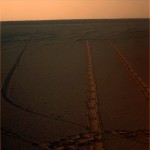QUOTE (fredk @ Sep 26 2008, 12:15 AM)

James, that's looking fantastic! Just a couple of remarks: could we see a higher-resolution crop of an area that contains extensive bedrock (eg Erebus highway) so we can see how the FT does there?
I'll try and make those 1/4 resolution plots for the whole of image this evening. Needed an early night last night so I just did a couple to show that it works.
QUOTE (fredk @ Sep 26 2008, 12:15 AM)

Also, there are lots of areas that are almost saturated red - perhaps the colour table could be tweaked to give more gradations of red so we can see more easily what's the worst of the worst and what's the best of the worst etc?
Yes, I had no real idea how big the numbers would get as it worked across the image so a lot of those in the etched terrain ended up saturated red. I'll rerun it with different scaling before making the maps tonight.
QUOTE (Juramike @ Sep 26 2008, 05:42 AM)

I was really hoping the Fourier transform method would solve all the problems: big dune detection, funky dune detection, finding safe bedrock zones.
Well at this stage that was never going to happen - my analysis explicitly looks for repeating E-W patterns at 8 - 28 pixel wavelengths - then plots the 'power' at that wavelength.
I think it's a reasonable assumption that big/funky dunes are more likely in 'big ripple areas'. In those areas it's also harder to navigate around obstacles and to navigate through in general. More elaborate schemes are probably possible but I'm not sure it's needed.
Purgatory was one isolated bump, not only that but it is surrounded by ripples that are small compared to some of the monsters found elsewhere, so the orange classification is what I would have expected (orange -> use caution, no blind drives like at Purgatory!). As I said before, this method with give you the areas that are generally more favourable for driving - but it doesn't mean Paolo can take his eyes off the road!
Any map that had the resolution to have every 'Purgatory' and dead end marked would end up being on a similar scale to the HiRISE image, so you might as well just use it as is!
My map should help to decide the general direction to minimise the chance of tripping over something nasty - then the HiRISE images themselves can be used to further refine the route - then the previous sols nav/pancams can be used to plot the actual drive. Simple!

James
 I'm pleased to see that Oppy has already passed through a much denser patch of 'red terrain' travelling down past Erebus to Victoria than anything that lies further south!
I'm pleased to see that Oppy has already passed through a much denser patch of 'red terrain' travelling down past Erebus to Victoria than anything that lies further south!







